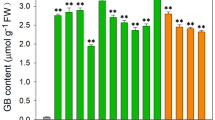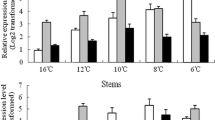Abstract
A betA gene encoding choline dehydrogenase from Escherichia coli was transformed into cotton (Gossypium hirsutum L.) via Agrobacterium-mediated transformation. Transgenic cotton plants exhibited improved tolerance to chilling due to accumulation of glycinebetaine (GB). The results of our experiment showed that GB contents of leaves of transgenic lines 1, 3, 4, and 5, both before and after chilling stress, were significantly higher than those of wild-type (WT) plants. At 15°C, transgenic lines 1, 3, 4, and 5 exhibited higher germination capacity as determined by the germination speed and final germination percentage and, displayed less inhibition in seedling shoot growth rate than WT plants. Under chilling stress, transgenic lines 4 and 5 maintained higher relative water content, upper carbon dioxide (CO2) fixation capacity and PSII electron transfer rate, better osmotic adjustment (OA), a lower percentage of ion leakage, and less lipid membrane peroxidation when compared with WT plants. Chilling resistance of the transgenic lines was demonstrated to be positively correlated with GB content under chilling stress. The high levels of GB in transgenic cotton plants might not only protect the integrity of cell membrane from chilling damage, but also be involved in OA which alleviated chilling induced water stress. Moreover, under chilling-stressed conditions, transgenic cotton plants enhanced stomatal conductance, PSII electron transport rate, and further leaf photosynthesis through accumulating high levels of GB.






Similar content being viewed by others
References
Ackerson RC (1981) Osmoregulation in cotton in response to water stress: II. Leaf carbohydrate status in relation to osmotic adjustment. Plant Physiol 67:489–493
Allakhverdiev SI, Hayashi H, Nishiyama Y, Ivanov AG, Aliev JA, Klimov VV, Murata N, Carpentier R (2003) Glycinebetaine protects the D1/D2/Cytb559 complex of photosystem II against photo-induced and heat-induced inactivation. J Plant Physiol 160:41–49
Allen DJ, Ort DR (2001) Impacts of chilling temperatures on photosynthesis in warm-climate plants. Trends Plant Sci 6:36–42
Arnon DI (1949) Copper enzymes in isolated chloroplasts: polyphenoloxidase in Beta vulgaris. Plant Physiol 24:1–15
Ashraf M, Foolad MR (2007) Roles of glycine betaine and proline in improving plant abiotic stress resistance. Environ Exp Bot 59:206–216
Bao YG, Zhao R, Li FF, Tang W, Han LB (2011) Simultaneous expression of Spinacia oleracea chloroplast choline monooxygenase (CMO) and betaine aldehyde dehydrogenase (BADH) genes contribute to dwarfism in transgenic Lolium perenne. Plant Mol Biol Report 29:379–388
Bradford M (1976) A rapid and sensitive method for quantification of microgram quantities of protein utilizing the principle of protein–dye binding. Anal Biochem 72:248–254
Bradow JM (1990) Chilling sensitivity of photosynthetic oil-seedlings. I. Cotton and sunflower. J Exp Bot 233:1585–1593
Bradow JM (1991) Cotton cultivar responses to suboptinal postemergent temperatures. Crop Sci 31:1595–1599
Brennan T, Frenkel C (1977) Involvement of hydrogen peroxide in the regulation of senescence in pear. Plant Physiol 59:411–416
Cakmak I, Strbac D, Marschner H (1993) Activities of hydrogen peroxide-scavenging enzymes in germinating wheat seeds. J Exp Bot 44:127–132
Chen TH, Murata N (2002) Enhancement of tolerance of abiotic stress by metabolic engineering of betaines and other compatible solutes. Curr Opin Plant Biol 5:250–257
Chen TH, Murata N (2008) Glycinebetaine: an effective protectant against abiotic stress in plants. Trends Plant Sci 13:499–505
Chen TH, Murata N (2011) Glycinebetaine protects plants against abiotic stress: mechanisms and biotechnological applications. Plant Cell Environ 34:1–20
Deng J, Jian L (2001) Advances of studies on plant freezing-tolerance mechanism: freezing tolerance gene expression and its function. Chin Bull Bot 18:521–530
DeRidder BP, Crafts-Brandner SJ (2008) Chilling stress response of postemergent cotton seedlings. Physiol Plant 134:430–439
Duan X, Song Y, Yang A, Zhang J (2009) The transgene pyramiding tobacco with betaine synthesis and heterologous expression of AtNHX1 is more tolerant to salt stress than either of the tobacco lines with betaine synthesis or AtNHX1. Physiol Plant 135:281–295
Fan L, Zheng S, Wang X (1997) Antisense suppression of phospholipase Dα retards abscisic acid and ethylene promoted senescence of postharbidopsis Arabidopsis leaves. Plant Cell 9:2183–2196
Farooq M, Aziz T, Hussain M, Rehman H, Jabran K, Khan MB (2008) Glycinebetaine improves chilling tolerance in hybrid maize. J Agron Crop Sci 194:152–160
Feng Z, Guo A, Feng Z (2003) Amelioration of chilling stress by triadimefon in cucumber seedlings. Plant Growth Regul 39:277–283
Fitzgerald TL, Waters DL, Henry RJ (2009) Betaine aldehyde dehydrogenase in plants. Plant Biol 11:119–130
Fracheboud Y, Haldimann P, Leipner J, Stamp P (1999) Chlorophyll fluorescence as a selection tool for cold tolerance of photosynthesis in maize (Zea mays L.). J Exp Bot 50:1533–1540
Genty B, Briantais JM, Baker NR (1989) The relationship between the quantum yield of photosynthetic electron transport and quenching of chlorophyll fluorescence. Biochem Biophys Acta 990:87–92
Giannopolitis CN, Ries SK (1977) Superoxide dismutases: I. Occurrence in higher plants. Plant Physiol 59:309–314
Gilmore AM (1997) Mechanistic aspects of xanthophyll cycle-dependent photoprotection in higher plant chloroplasts and leaves. Physiol Plant 99:197–209
Giri J (2011) Glycinebetaine and abiotic stress tolerance in plants. Plant Signal Behav 11:1746–1751
Gorham J (1996) Glycinebetaine is a major nitrogen-containing solute in the Malvaceae. Phytochemistry 43:367–369
He C, Yang A, Zhang W, Gao Q, Zhang J (2010) Improved salt tolerance of transgenic wheat by introducing betA gene for glycine betaine synthesis. Plant Cell Tissue Organ Cult 101(1):65–78
Hetherington SE, Smillie RM, Hardacre AK, Eagles HA (1983) Using chlorophyll fluorescence in vivo to measure the chilling tolerances of different populations of maize. Aust J Plant Physiol 10:247–256
Hoagland DR, Arnon DI (1950) The water-culture method for growing plants without soil. University of California Agricultural Experimentation Station, Berkeley, CA, Circular no. 347, pp 1–39
Holmström KO, Somersalo S, Mandal A, Palva TE, Welin B (2000) Improved tolerance to salinity and low temperature in transgenic tobacco producing glycine betaine. J Exp Bot 51:177–185
Horton P, Ruban AV, Walters RG (1996) Regulation of light harvesting in green plants. Annu Rev Plant Physiol Plant Mol Biol 47:655–684
Jiang M, Miao LX, He CM (2011) Overexpression of an oil radish superoxide dismutase gene in broccoli confers resistance to downy mildew. Plant Mol Biol Report. doi:10.1007.s11105-011-0407-1
Königer M, Winter K (1993) Reduction of photosynthesis in sun leaves of Gossypium hirsutum L. under conditions of high light intensities and suboptimal leaf temperatures. Agronomie 13:659–668
Kramer PJ, Boyer JS (1995) Water relations of plants and soils. Academic, San Diego, California, USA
Kratsch HA, Wise RR (2000) The ultrastructure of chilling stress. Plant Cell Environ 23:337–350
Landfald B, Strom AR (1986) Choline-glycine betaine pathway confers a high level of osmotic tolerance in Escherichia coli. J Bacteriol 165:849–855
Lv S, Yang A, Zhang K, Wang L, Zhang J (2007) Increase of glycinebetaine synthesis improves drought tolerance in cotton. Mol Breed 20:233–248
Maehly A, Chance B (1954) The assay of catalases and peroxidases. Methods Biochem Anal 1:357–424
Mahan JR, Gitz DC III, Payton PR, Allen R (2009) Overexpression of glutathione reductase in cotton does not alter emergence rates under temperature stress. Crop Sci 49:272–280
Mäkelä P, Kontturi M, Pehu E, Somersalo S (1999) Photosynthetic response of drought-and salt-stressed tomato and turnip rape plants to foliar-applied glycinebetaine. Physiol Plant 105:45–50
Melkonian J, Yu LX, Setter TL (2004) Chilling responses of maize (Zea mays L.) seedlings: root hydraulic conductance, abscisic acid, and stomatal conductance. J Exp Bot 55:1751–1760
Mittler R (2002) Oxidative stress, antioxidants and stress tolerance. Trends Plant Sci 7:405–410
Oosterhuis DM, Wullschleger SD (1987) Osmotic adjustment in cotton (Gossypium hirsutum L.) leaves and roots in response to water stress. Plant Physiol 84:1154–1157
Park EJ, Jeknić Z, Sakamoto A, DeNoma J, Yuwansiri R, Murata N, Chen TH (2004) Genetic engineering of glycinebetaine synthesis in tomato protects seeds, plants, and flowers from chilling damage. Plant J 40:474–487
Park EJ, Zoran J, Chen THH (2006) Exogenous application of glycinebetaine increases chilling tolerance in tomato plants. Plant Cell Physiol 47:706–714
Park EJ, Jeknić Z, Chen THH, Murata N (2007) The codA transgene for glycinebetaine synthesis increases the size of flowers and fruits in tomato. Plant Biotechnol J 5:422–430
Payton P, Webb R, Kornyeyev D, Allen R, Holaday AS (2001) Protecting cotton photosynthesis during moderate chilling at high light intensity by increasing chloroplastic antioxidant enzyme activity. J Exp Bot 52:2345–2354
Prochazkova D, Wilhelmova N (2007) Leaf senescence and activities of the antioxidant enzymes. Biol Plant 51:401–406
Quan R, Shang M, Zhang H, Zhao Y, Zhang J (2004) Improved chilling tolerance by transformation with betA gene for the enhancement of glycinebetaine synthesis in maize. Plant Sci 166:141–149
Saneoka H, Nagasaka C, Hahn DT, Yang WJ, Premachandra GS, Joly RJ, Rhodes D (1995) Salt tolerance of glycinebetaine-deficient and -containing maize lines. Plant Physiol 107:631–638
Troll W, Cannan RK (1953) A modified photometric ninhydrin method for the analysis of amino and imino acids. J Biol Chem 200:803–811
Van Heerden PD, Viljoen MM, De Villiers MF, Kruger GH (2004) Limitation of photosynthetic carbon metabolism by dark chilling in temperate and tropical soybean genotypes. Plant Physiol Biochem 42:117–124
**ng W, Rajashekar CB (2001) Glycine betaine involvement in freezing tolerance and water stress in Arabidopsis thaliana. Environ Exp Bot 46:21–28
Xu CX, Zheng L, Gao CQ, Wang C, Liu GF, Jiang J, Wang YC (2011) Ovexpression of a vacuolar H+-ATPase c subunit gene mediates physiological changes leading to enhanced salt tolerance in transgenic tobacco. Plant Mol Biol Report 29:424–430
Yang X, Lu C (2005) Photosynthesis is improved by exogenous glycinebetaine in salt-stressed maize plants. Physiol Plant 124:343–352
Yang X, Liang Z, Lu C (2005) Genetic engineering of the biosynthesis of glycinebetaine enhances photosynthesis against high temperature stress in transgenic tobacco plants. Plant Physiol 138:2299–2309
Yang X, Zheng L, Wen X, Lu C (2008) Genetic engineering of the biosynthesis of glycinebetaine leads to increased tolerance of photosynthesis to salt stress in transgenic tobacco plants. Plant Mol Biol 66:73–86
Yemm EW, Willis AJ (1954) The estimation of carbohydrates in plant extracts by anthrone. Biochem J 57:508–514
Zeng QW, Qin S, Song SQ, Zhang M, **ao YH, Luo M, Hou L, Pei Y (2012) Molecular cloning and characterization of a cytokinin dehydrogenase gene from upland cotton (Gossypium hirsutum L.). Plant Mol Biol Report 30:1–9
Zhang J, Tan W, Yang X, Zhang HX (2008) Plastid-expressed choline monooxygenase gene improves salt and drought tolerance through accumulation of glycinebetaine in tobacco. Plant Cell Rep 27:1113–1124
Zhang H, Dong H, Li W, Sun Y, Chen S, Kong X (2009) Increased glycine betaine synthesis and salinity tolerance in AhCMO transgenic cotton lines. Mol Breed 23:289–298
Zhang F, Liu X, Zuo KJ, Zhang JQ, Sun XF, Tang KX (2011) Molecular cloning and characterization of a novel Gossypium barbadense L. RAD-like gene. Plant Mol Biol Report 29:324–333
Zhao SJ, Xu CC, Zhou Q, Meng QW (1994) Improvements of method for measurement of malondialdehyde in plant tissues. Plant Physiol Commun 30:207–210, in Chinese
Acknowledgments
We thank the National Natural Science Foundation of China (31172028), the programs involved in research on transgenic plants in China (2011ZX08005-004), and Shandong Province Science and Technology Development Plan (2009GG10009010 and 2010GNC10910). We are grateful to Dr. Yongbin Yan in Tsinghua University for help in GB determination using 1H NMR spectroscopy. We also thank International Science Editing for assistance in language editing of the manuscript.
Author information
Authors and Affiliations
Corresponding author
Rights and permissions
About this article
Cite this article
Zhang, K., Wang, J., Lian, L. et al. Increased Chilling Tolerance Following Transfer of a betA Gene Enhancing Glycinebetaine Synthesis in Cotton (Gossypium hirsutum L.). Plant Mol Biol Rep 30, 1158–1171 (2012). https://doi.org/10.1007/s11105-012-0433-7
Published:
Issue Date:
DOI: https://doi.org/10.1007/s11105-012-0433-7




